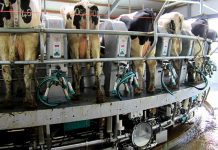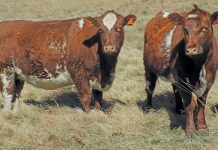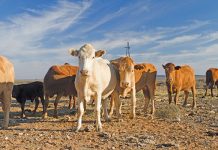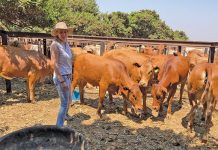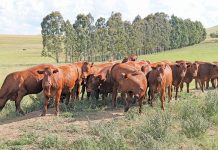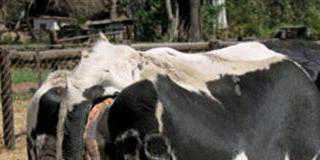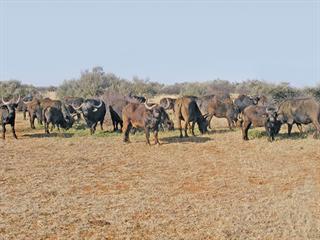
Buffalo are carriers of, or are prone to, a number of diseases that are dangerous to cattle. According to state veterinarian Dr Pierre Nel, this can have serious consequences for livestock farmers. “Buffalo can carry several harmful diseases, with a huge potential impact on cattle and disease- free buffalo,” he says. “We should manage these diseases carefully to protect our cattle.”
Corridor disease
One of the most important diseases associated with buffalo breeding, and fatal in cattle, is Corridor disease. Buffalo are the only natural carriers of this disease, which was first recognised in Zimbabwe in 1943 and reported 20 years later in South Africa in the corridor between the Hluhluwe and Umfolozi game reserves in Zululand.
The disease is caused by the one-cellular protozoan parasite Theileria parva ssp. lawrencei, transmitted from buffalo to cattle by the brown ear tick Rhipicephalus appendiculatus and the Lowveld brown ear tick R. zambeziensis. In cattle, the mortality rate usually exceeds 80%, with infected animals dying after five to 15 days.
“This is the most important tick-transmitted disease in Africa,” Nel says. “It’s endemic to Kenya, Tanzania, Uganda, southern Sudan, Rwanda, Burundi, Zaire, Malawi, Zambia, Zimbabwe and Mozambique, and kills about a million cattle annually.” On clinical, epidemiological and serological evidence, and later on DNA sequencing, the Theileria parva group has been divided into three subgroups causing respectively East Coast Fever, seasonal Zimbabwean disease and Corridor disease.
The incubation period for Corridor disease is between nine and 20 days, averaging 12 days. Fever and clinical signs develop from six to 13 days after infection and the parasite reaching the lymph nodes. Cattle usually die from fluid in the lungs and symptoms include fever, swollen lymph nodes, weight loss, weakness and muscle tremors, lachrymation (tears), difficult breathing, frothing at the nose and fluid in the lungs.
“Corridor disease is not a high-risk disease in the Free State, except in the Parys-Vredefort Dome area where the brown ear tick occurs,” Nel says. “There is no scientifically confirmed reason why some cattle, albeit very few, survive this disease. With the wide genetic variation in Theileria parasites, there may be minor differences in virulence.
“Another possible reason is that Zebu cattle (Bos indicus) enjoy a higher innate immunity against endemic parasites than Bos taurus cattle from Europe. If a cow received a tetracycline injection for another condition while by chance being infected with T.p. lawrencei, it will, for all practical purposes, be naturally vaccinated and become a carrier.
If an infected brown ear tick attaches to a cow, it will take three to four days for the sporozoites to become infective. If the cow’s immune reaction against the tick interferes at the beginning of this infective stage, or if it’s dipped, it could theoretically become infected with a very low number of parasites, giving its immune system the opportunity to overcome the disease.”
Bovine Catarrhal Fever
Bovine Catarrhal Fever (BCF) is an acute disease occurring virtually worldwide in cattle, Asian and African buffalo, and a wide range of antelope and deer species kept in confinement. It is usually fatal in cattle and some other ungulates such as buffalo.
Veterinarian Dr Thys de Vries says the virus that causes the disease is a member of the Gammaherpesvirinae family. The disease alcelaphine herpesvirus Type 1 (AlHV- 1) is associated with blue and black wildebeest in Africa. Herpesvirus in red hartebeest, roan antelope and deer are not associated with BCF.
In Africa, wildebeest carry a lifelong infection of AlHV-1 without showing symptoms. The virus is passed from mother to offspring and shed mostly in the nasal secretions of calves under one year old. The wildebeest are infected in uterus or between calves of up to five months. Cattle and buffalo can be infected by contact with wildebeest calves between two and three months old.
Cattle and buffalo are the terminal hosts of the disease and no infection between cattle and between buffalo takes place. Infection also does not occur between cattle and buffalo. The incubation period is between two and four weeks, but could be up to seven months.
The symptoms include high fever, anorexia, secretions from the nose and eyes, and erosion of the tongue, lips and cheeks. Ensuing conjunctivitis could lead to blindness, while necrotic skin infections, swollen lymph nodes and convulsions are typical.
“The wildebeest-associated BCF is an acute disease that usually causes death in infected cattle and buffalo,” De Vries says.
“The incidence of clinical BCF in buffalo is relatively low, but the increased translocation of buffalo could lead to an increased risk of contracting the disease.”
Bovine Tuberculosis
Bovine tuberculosis is a bacterial infection caused by Mycobacterium bovis. This bacterium is an intracellular pathogen and the disease is slow and progressive. Bovine tuberculosis is controlled in terms of the Animal Diseases Act 35 of 1984. State veterinarian Dr Irene Fick says that this disease can be traced back to the days of the Roman Empire.
In South Africa, the first reference to the disease was in 1880 and it was declared notifiable in 1911.
“It was identified in the Kruger National Park’s buffalo and in a private KwaZulu-Natal game reserve in 1991/1992,” says Fick. “From there, it spread to various game reserves and game farms in South Africa.”
The disease affects mainly the respiratory system and associated lymph nodes as well as the gastro-intestinal tract, the reproductive tract, mammary glands and the central nervous system. The main transmission route is via respiratory aerosol. Buffalo, as large gregarious animals, are an ideal host for the disease. They congregate in large numbers and in close contact with one another. Young animals moving between herds and seasonal herd mixing also help to transmit the disease.
The disease has no symptoms in the early stage but in the advanced stage causes diffuse lesions in the respiratory tract, metritis and mastitis in the udder. The symptoms and diffuse lesions progress during stress episodes and physical exertion such as calving.
Symptoms could also include moist coughing in the early morning, during cold weather or after exercise; obstructed airways and blood vessels; and bloating. Metritis may inhibit conception, cause genital lesions or lead to abortion during advanced pregnancy. Symptoms may include enlargement of the supramammary lymph nodes leading to hardening and enlargement of hindquarters. Enlarged glands without palpable lesions in the udder point to TB mastitis. The infected animal’s milk initially looks normal but eventually becomes flaky and then turns yellow and brown.
“The disease must be carefully monitored as it could have a dire effect on animal health,” Fick explains. “Cattle tested positive in a localised herd in the Free State in 2011 and buffalo tested positive on one farm in the province in 2014. All the animals that tested positive were destroyed and others are continually re-tested. “Buffalo breeders must put strict biosecurity networks in place, ensure that cattle on adjoining farms are free from the disease, and prevent close contact with cattle and other game.”
Brucellosis in African Buffalo
Brucellosis was present in domestic and wild ruminants in East Africa before cattle were introduced from other continents. It was brought to Southern Africa via cattle imported from Europe. The disease is caused by Brucella bacteria present in aborted foetuses and uterine secretions. Bulls servicing infected cows can also contract it. Buffalo are ideal hosts for the bacteria due to the species’ gregarious nature, among other reasons.
“The incubation period for Bovine brucellosis or contagious abortion (CA), as it is also known, is long and variable. It depends on the infected animal’s sex, age, sexual maturity and stage of pregnancy,” says state veterinarian Dr Jacoba Dongo. “The Brucella bacteria hide from and actively suppress the immune response in affected bovines, including buffalo. Up to 80% of infected cows abort or give birth to still-born or weakened calves. Some 90% of infected cows remain chronically infected while 2,5% to 9% of heifers born to serologically positive cows are latently infected.”
She warns that the spread of the disease in South Africa appears to be increasing. Since 2003, more than 250 outbreaks have been reported annually, with 78 outbreaks in the first two months of 2014. Affected animals show very few, if any, symptoms until the disease is at a very advanced stage.
“If it gets into an unvaccinated herd, between 30% and 70% of the cows in-calf may be infected, but the rate seldom exceeds 50%. Bovine brucellosis is an erosive disease that destroys profit. The rule of thumb is to have a cattle herd tested after the second abortion in two weeks while a buffalo herd should be tested after the first abortion.”
Phone Dr Irene Fick on 051 436 3677 or email [email protected]. Phone Frans Schutte on 083 301 9930 or email [email protected]

